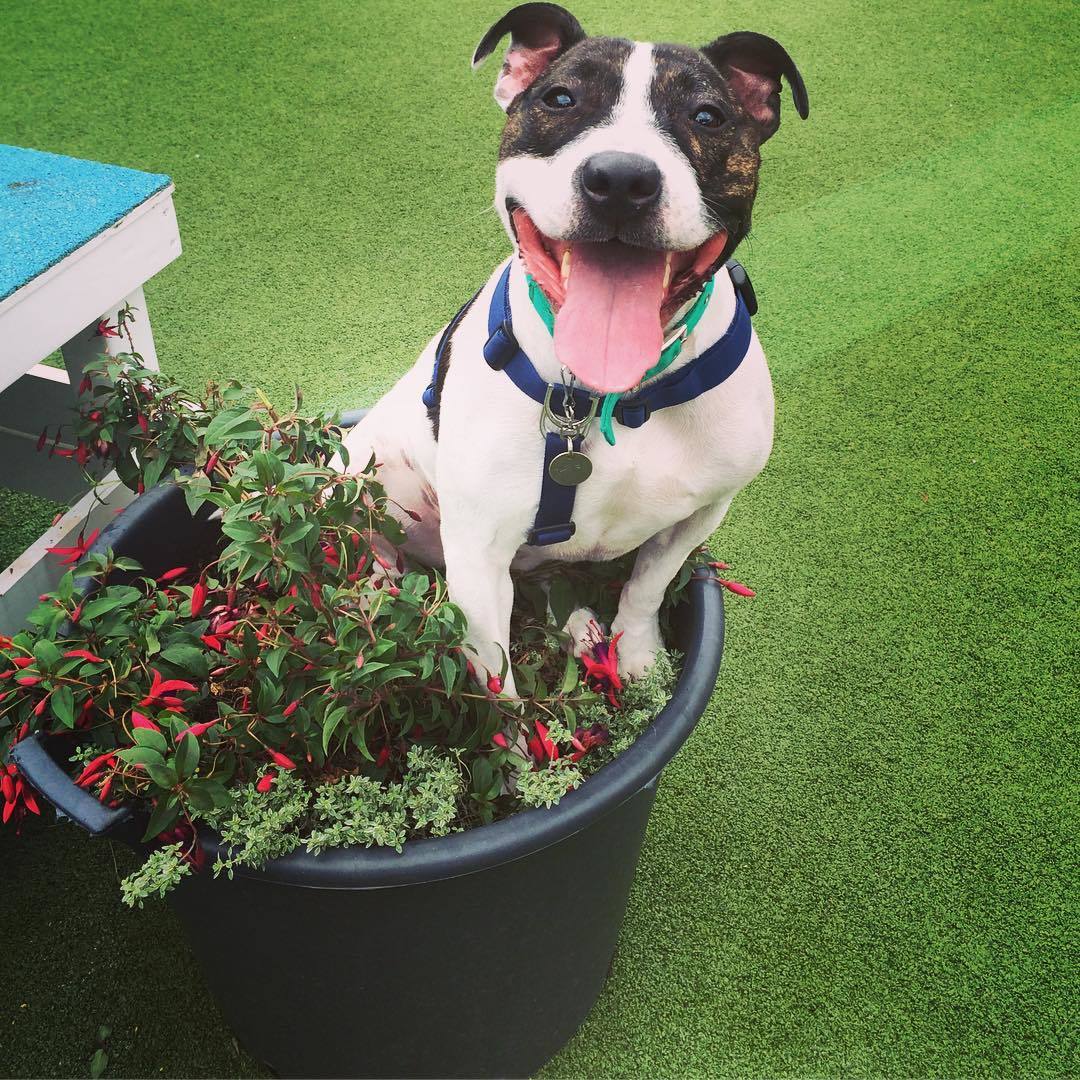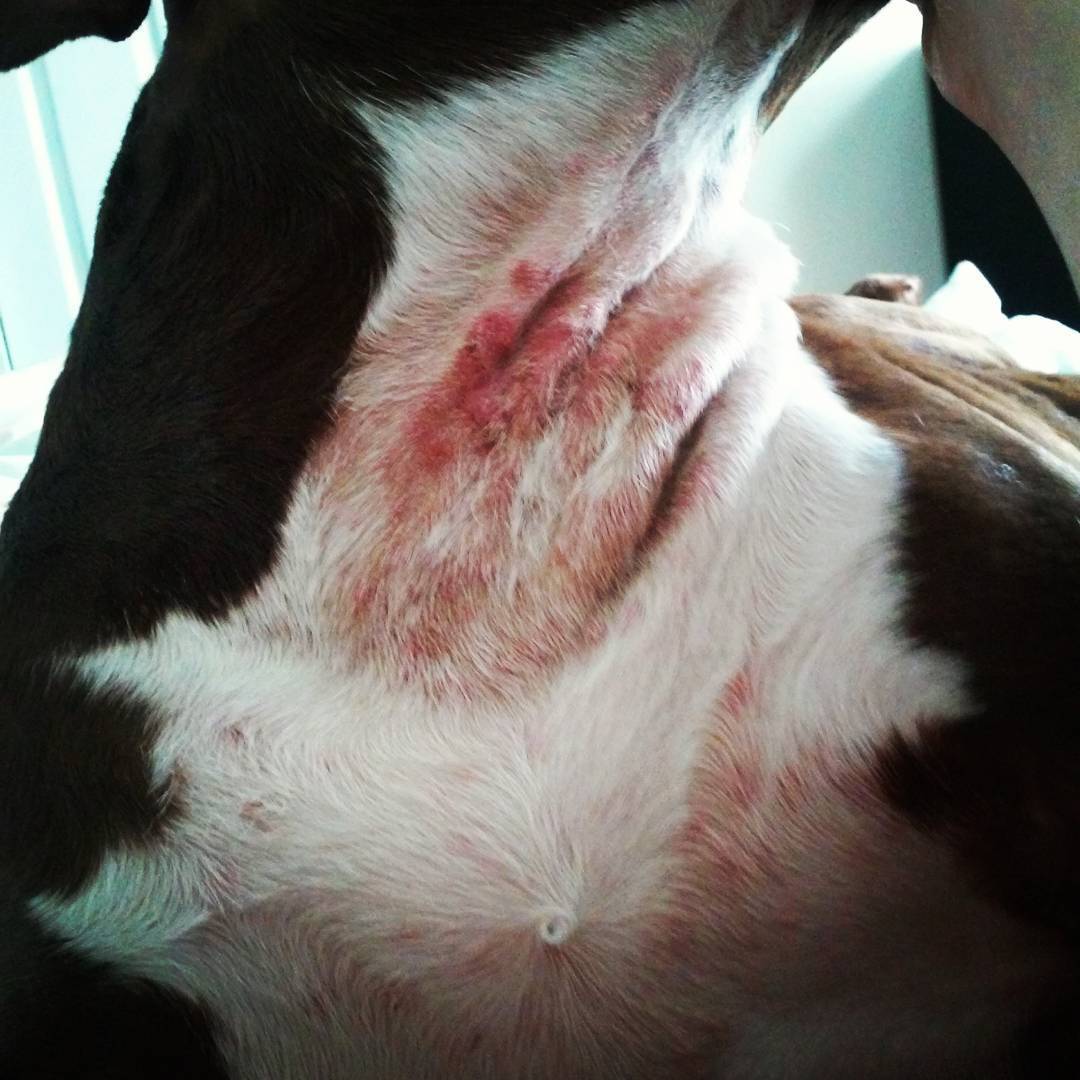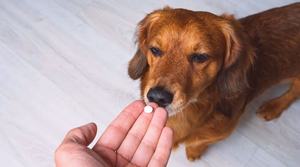This article has been medically reviewed by Dr. Chyrle Bonk, DVM.
Canine atopic dermatitis is an inflammatory disease of the skin caused by an allergic reaction to ingredients in food or things in the environment. It causes red, dry and itchy skin.
Just like humans, some dogs can develop allergies to grass, foods, pollen, dander or other things in the environment.
A "grass allergy" is triggered by the pollen that comes off certain grasses particularly during the spring and summer, mainly mid-May to mid-July.
These tiny spores are capable of eliciting an allergic reaction in some dogs where their immune system overreacts to having the pollen in their body. The result is inflammation in the form of redness, swelling and itchiness.
Environmental allergies aren't limited to grasses. Insect pollinated flowers can also trigger an allergic reaction.

Photo Credit: Instagram/Bexdisney
All dog breeds can develop an allergy to grass pollen at any point in their lives, but, there is a higher risk in the following breeds:
- Boxers
- Pugs
- Dalmatians
- Shar-Peis
- Terriers
- Retrievers
- Bulldogs
- German Shepherds
- Setters
- Miniature Schnauzers
- Cocker Spaniels
Diagnosing Grass Pollen Allergies in Dogs
Determining whether your dog has a grass allergy can take some time. The method that you can do at home is to not let your dog in the grass for a couple of weeks.
If symptoms get better or clear up, you can let them out in the grass again. If symptoms come back, you know you're dealing with a grass allergy.
Since dogs can be allergic to many different things in their environment besides just grasses, allergy testing to pinpoint the exact triggers may be necessary.
A serum (blood) allergy test or an intradermal skin allergy test (IDST), which is carried out by an animal dermatologist may be used to see if grass pollen is the culprit.
The IDST test is considered the better of the two to help identify the relevant allergen.
Symptoms of Grass Allergies in Dogs

Photo Credit: Instagram/ricki.and.lori
The most common symptoms of a grass allergy are: scratching, rash, excessive licking, skin redness, and running of the eyes and nose. In severe cases it may even cause difficulty breathing. Coughing, sneezing, and wheezing may also occur.
Here is a complete list of symptoms if your dog develops an allergic reaction to grass.
- Itchy skin
- Diarrhea
- Hairloss (from scratching)
- Constant licking
- Scratching
- Biting/chewing on tail and paws
- Red rash/dry belly
- Sore paws
- Sneezing
- Snoring
- Crusty or moist skin
For snoring remedies read our post on how to stop your dog from snoring here.
Prevention of Grass Allergy Flare-ups
Of course, the best way to prevent a flare-up from grass allergies is to avoid being in the grass all together. This is definitely easier said than done, especially since most pups love to be out in the grass.
So, rather than confining your dog strictly indoors, try a few of these methods:
- Grass boots can be worn by your dog when you let them outside to protect against grass contact. These are particularly great if your pup gets swollen paws and abscesses.
- Keep your grass cut short!
- Mow your yard before seed heads are produced to help decrease the amount of pollen.
- Remove any weeds since these can also trigger allergies in your pet.
- Bath your dog regularly to remove allergens. Wipe their feet when they come in from outside.
- Use an air filter in your home to remove pollen and mold from the air.
Common weeds that flare up grass allergies include:
- Russian Thistle
- Dog Fennel
- English Plantain
- Mugworts
- Marsh Elder
- Dandelions
- Sorrels
- Sage brushes
- Burning Bush
Treatment
Before beginning treatment, allergy testing with your veterinarian can be a valuable way to see what your pup is sensitive to. After that, it's all about controlling the inflammation on the skin in the following ways.
Topical products: shampoos, topical ointment such as a cortisone cream (Triamcinolone Topical) or gel, sprays can be used on smaller areas.
Oral products: corticosteroids, antihistamines, fatty acids, cyclosporine are more commonly used for issues affecting larger areas.
Topical Shampoos & Conditioners

Photo Credit: Instagram/the_vegan_concept
These are medicated shampoos for treating dogs with sensitive or inflamed skin. If your dog is super itchy look for a sensitive canine shampoo to help relieve symptoms. Choose from either an Oatmeal, Aloe-Vera or a Herbal Shampoo.
Pros
Cons
Fatty Acid Supplements
These are of the Omega-3 and Omega-6 fatty acids that are natural anti-inflammatories. Omega fatty acids can be taken orally or rubbed onto itchy skin.
Pros
Cons
Antihistamines
These include: Zyrtec, Benadryl, Tavist, Claritin, Temaril and Elavil. In the case of antihistamines, there may be a little trial and error until you find the right one for your pup. Generally a couple of weeks is required for the antihistamines to work. First check in with your veterinarian for the correct dose to give your dog especially if they are on any other medications to be on the safe side.
Pros
Cons
Corti-costeroids
Corti-costeroids such as prednisolone and prednisone may be prescribed by your vet. These are strong anti-inflammatories and are usually used as a last ditch effort since long-term use can come with some side effects.
Pros
Cons
Cyclosporine
Cyclosporine is an immunomodulator, which means that it controls immune function in dogs. This helps to decrease the immune system’s reaction to allergens.
Pros
Cons
Finally
It is frustrating and sad to see your pup suffer with skin allergies and feeling helpless.
The first step is to identify the allergens causing the problem and try to avoid them.
Consult your vet to find out what is the best way for you to determine what your dog is allergic to and how you can best treat and avoid it.



